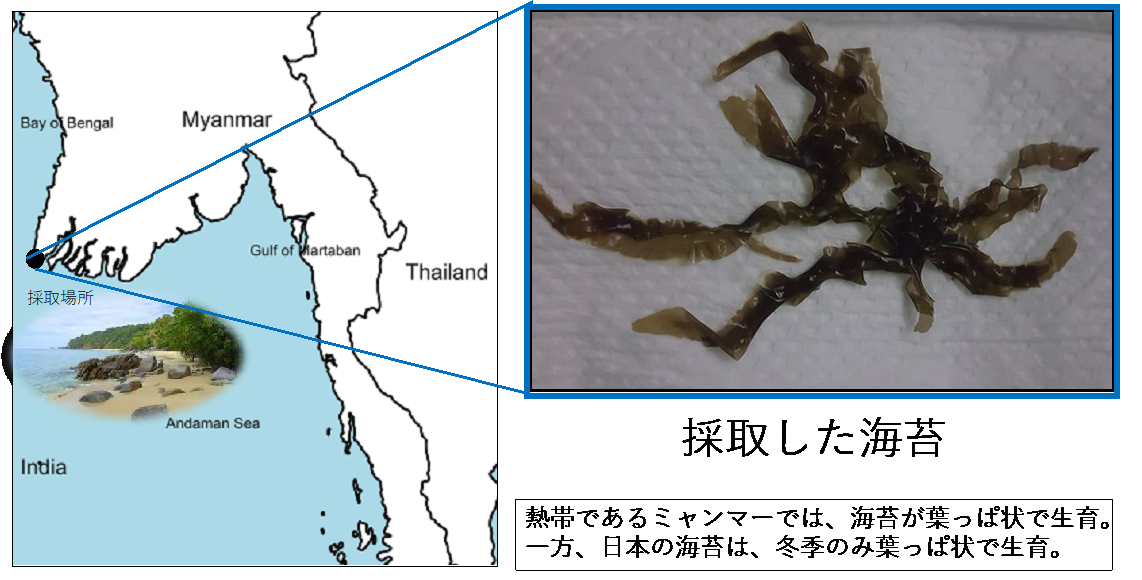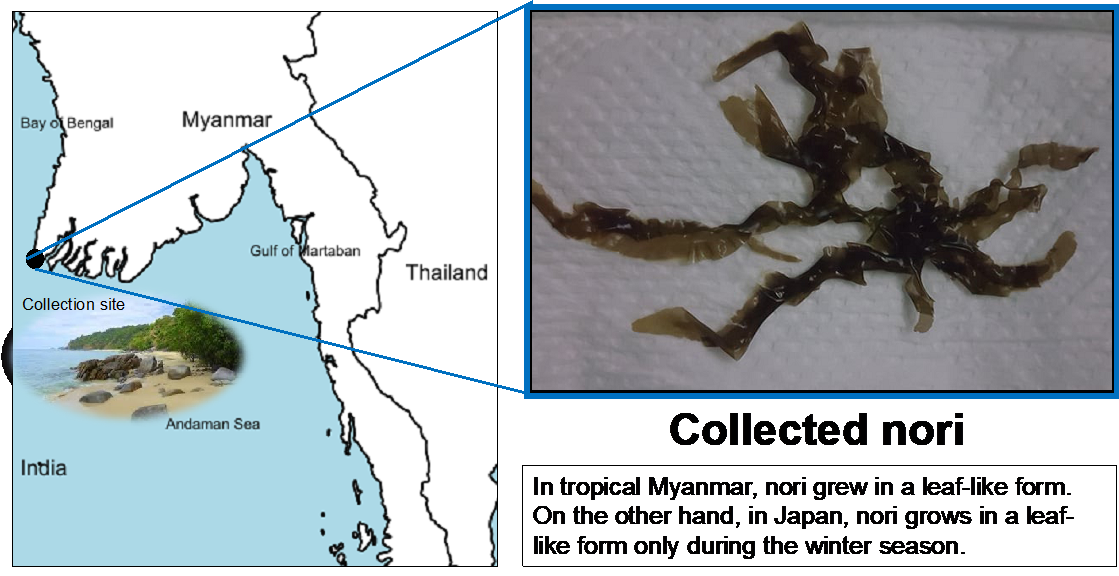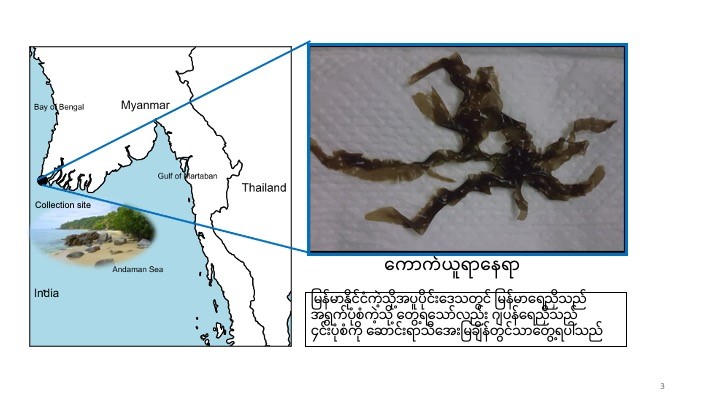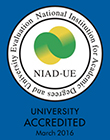ミャンマー出身の大学院生がミャンマー産高温耐性海苔の研究成果を発表

【研究者】
ミャット・トュー・サン(Myat Htoo San)
(佐賀大学総合分析実験センター、鹿児島大学大学院連合農学研究科、大学院生)
【研究成果の概要】
ミャンマー出身の大学院生、ミャット・トュー・サン(Myat Htoo San)は、ミャンマー産の高温耐性海苔についての新研究成果を発表しました。
ミャット・トュー・サンは、2019年8月にミャンマーの南西海岸で海苔を採取しました。その後、同年10月より国費留学生として佐賀大学に入学し、この海苔の研究を開始しました。
最初に、日本産海苔(スサビノリ)と亜熱帯性の日本産海苔(タネガシマアマノリ)とミャンマー産海苔の生育条件を比較しました。その結果、ミャンマー産の海苔は圧倒的に高温に耐性があることを確認しました。
さらに、遺伝子解析を行い、ミャンマー産海苔の葉緑体およびミトコンドリアの全ゲノム配列を解読しました。その結果、ミャンマー産海苔は、生理的特性が大いに異なるにも関わらず、タネガシマアマノリと比較的近縁であることが判明しました。
現在、温暖化によって有明海の海苔の生産が危機に瀕しています。そこで、熱帯地域の海苔であるミャンマー産海苔と、日本の海苔がどう違うのかを明らかにすることは、有明海の問題の解決への糸口となります。
この研究成果は、2023年9月21日に英科学誌「Scientific Reports」に掲載されました。

【研究成果の公表媒体(論文や学会など)】
雑誌名
Scientific Reports(Nature Portfolio;2023年9月21日掲載)
論文タイトル
Characterization and organelle genome sequencing of Pyropia species from Myanmar
著者
Myat Htoo San1,2, 川村嘉応3, 木村圭1,3, Eranga Pawani Witharana4, 下桐猛1,5, San San Aye6, Thu Thu Min7, Cherry Aung8, Moe Moe Khaing9, 永野幸生1,2,4
1.鹿児島大学大学院連合農学研究科
2.佐賀大学総合分析実験センター
3.佐賀大学農学部
4.佐賀大学大学院先進健康科学研究科
5.鹿児島大学農学部
6.モーラミャイン大学(ミャンマー)
7.パテイン大学(ミャンマー)
8.ミェイク大学(ミャンマー)
9.ダウェイ大学(ミャンマー)
【今後の展開】
ミャンマー産海苔と、日本の海苔がどう違うのかを、より詳細に調べます。具体的には、核ゲノム配列も決定し、この情報を参考に、全遺伝子の発現がどう違うのかを調べます。その上で、気候変動が進行する中での海苔生産の危機に対する新しい解決策を模索します。更には、ミャンマー等の熱帯域での海苔の生産への糸口にもします。
【その他PRしたい特記事項】
ミャット・トュー・サンは、我が国の国費外国人留学生制度、及び、笹川科学研究助成(日本科学協会)の支援をうけて、この研究を行いました。
【本件に関する問い合わせ先】
ミャット・トュー・サン(Myat Htoo San)
佐賀大学総合分析実験センター
鹿児島大学大学院連合農学研究科
〒840-8502 佐賀県佐賀市本庄町1番地
TEL: 0952-28-8898
E-mail:k1747459@kadai.jp
Graduate Student from Myanmar Publishes
Research on Heat-Resistant Seaweed Native to Myanmar
【Researcher】
Myat Htoo San
(Analytical Research Center for Experimental Sciences, Saga University; The United Graduate School of Agricultural Sciences, Kagoshima University; Graduate Student)
【Summary of Research Findings】
Ms. Myat Htoo San, a graduate student from Myanmar, has announced new research findings on heat-resistant seaweed (nori) native to Myanmar. She collected seaweed samples from the southwestern coast of Myanmar in August 2019. Subsequently, she enrolled in Saga University in October of the same year as an international student and began her research on this seaweed.
Initially, she compared the growth conditions of seaweed native to Japan (Susabi nori) and subtropical seaweed native to Japan (Tanegashima Amanori) with those of Myanmar-native seaweed. The results confirmed that seaweed from Myanmar has significantly higher heat resistance.
Further, she performed genetic analysis, decoding the complete genome sequences of the chloroplasts and mitochondria of the Myanmar-native seaweed. The results revealed that despite significantly differing physiological traits, the seaweed is relatively closely related to Tanegashima Amanori.
Presently, seaweed production in the Ariake Sea (Ariake Sound) is endangered due to global warming. Therefore, clarifying the differences between tropical seaweed from Myanmar and seaweed from Japan will provide a clue for solving the problems in the Ariake Sea.
This research has been published in the British scientific journal “Scientific Reports” on September 21, 2023.

【Publication Media (Journals, Conferences, etc.)】
Journal: Scientific Reports (Nature Portfolio; Published September 21, 2023)
Title: Characterization and organelle genome sequencing of Pyropia species from Myanmar
Authors: Myat Htoo San1,2, Yoshio Kawamura3, Kei Kimura1,3, Eranga Pawani Witharana4, Takeshi Shimogiri1,5, San San Aye6, Thu Thu Min7, Cherry Aung8, Moe Moe Khaing9, Yukio Nagano1,2,4
1.The United Graduate School of Agricultural Sciences, Kagoshima University, Japan
2.Analytical Research Center for Experimental Sciences, Saga University, Japan
3.Faculty of Agriculture, Saga University, Japan
4.Graduate School of Advanced Health Science, Saga University, Japan
5.Faculty of Agriculture, Kagoshima University, Japan
6.Mawlamyine University, Myanmar
7.Pathein University, Myanmar
8.Myeik University, Myanmar
9.Dawei University, Myanmar
【Future Plans】
The differences between seaweed from Myanmar and seaweed from Japan will be studied in greater detail. Specifically, nuclear genome sequencing will be conducted, and these findings will be used to examine how the expression of all genes differs. Based on this, new solutions to the crisis of seaweed production amidst climate change will be explored. This could also lead to insights into seaweed production in tropical regions like Myanmar.
【For Other Special Notes for PR】
Ms. Myat Htoo San conducted this research with the support of the Japanese Government (Monbukagakusho:MEXT) Scholarships and the Sasakawa Scientific Research Grant from the Japan Science Society.
【For Inquiries Regarding This Matter】
Myat Htoo San
Analytical Research Center for Experimental Sciences, Saga University
The United Graduate School of Agricultural Science, Kagoshima University
Address: 1 Honjo-machi, Saga 840-8502, Japan
TEL: 0952-28-8898
E-mail: k1747459@kadai.jp
မြန်မာနိုင်ငံမှအပူဒဏ်ခံနိုင်သောရေညှိမျိုးစိတ်အားသုတေသနပြုလုပ်ခြင်း
သုတေသနဆောင်ရွက်သူ
မြတ်ထူးစံ
သုတေသနရလဒ်အနှစ်ချုပ်
မြတ်ထူးစံသည် မြန်မာနိုင်ငံမှာ ဘွဲ့လွန်ပညာလာရောက်ဆည်းပူးနေခြင်းဖြစ်ပီး အပူဒဏ်ခံနိုင်သော မြန်မာနိုင်ငံမှ ရေညှိမျိုးစိတ်သစ်အားသုတေသနပြုလုပ်ခဲ့ပါသည်။ ၂၀၁၉
ခုနှစ် ဩဂုတ်လတွင် အထက်ဖော်ပြပါရေညှိမျိုးစိတ်နမူနာများကို မြန်မာနိုင်ငံ အနောက်တောင်ကမ်းရိုးတမ်းဘက်မှ စုဆောင်းခဲ့ပါသည်။ ထိုအချိန်မှစ၍ မမြတ်ထူးစံသည် ဂျပန်နိုင်ငံ saga တက္ကသိုလ်တွင် ဘွဲ့လွန်တန်း တက်ရောက်သင်ကြားကာ မြန်မာ့ရေညှိများအကြောင်းကို သုတေသနဆောင်ရွက်ခဲ့ပါသည်။
သုတေသန ပထမအဆင့်အနေဖြင့် မြန်မာ့ရေညှိမျိုးစိတ်များကို ဂျပန်နိုင်ငံ၏ ရေညှိမျိုးစိတ်များဖြစ်သော ဂျပန်နိုရီ (susabi nori) နှင့် ဂျပန်အပူပိုင်းဒေသပေါက်နိုရီ (Tanegashima Amanori) နှင့် နှိုင်းယှဉ်စိုက်မျိုးကာ ဇီဝကမ္မကွဲပြားမှုများအားလေ့လာခဲ့ပါသည်။ သုတေသနတွေ့ရှိချက်အရ မြန်မာ့ရေညှိသည် ဂျပန်အပူပိုင်းဒေသပေါက်နိုရီ (Tanegashima Amanori) ထက်ပင် အပူဒဏ်ကို သိသိသာသာခံနိုင်ရည်ရှိကြောင်းကို အတည်ပြုနိုင်ခဲ့ပါသည်။
ထို့နောက် မြန်မာ့ရေညှိ၏ ဆဲလ်တွင်းပါဝင်ပစ္စည်းများဖြစ်သော chloroplast နှင့် mitochondria sequences များအား သတ်မှတ်အတည်ပြုနိုင်ခဲ့ပီး ထိုအချက်အလက်များကို အသုံးချကာ genomic level စမ်းစစ်ချက်များဖြင့် ဆက်လတ်သုတေသန ပြုလုပ်ဆောင်ရွက်ခဲ့ပါသည်။ ရလဒ်အနေဖြင့် မြန်မာ့ရေညှိနှင့် ဂျပန်အပူပိုင်းဒေသပေါက်နိုရီ (Tanegashima Amanori) သည် ဇီဝကမ္မဗေဒအားဖြင့်ကွဲပြားသော်လည်း မျိုးရိုးဗီဇအရ နီးကပ်စွာဆပ်နွယ်နေကြောင်း လေ့လာတွေ့ရှိရပါသည်။
ယခုလက်ရှိတွင် ကမ္ဘာပူနွေးလာမှု၏အကျိုးဆက်တစ်ခု အနေဖြင့် ဂျပန်နိုင်ငံ၏ရေညှိများ အဓိကစိုက်ပျိုးထုတ်လုပ်ရာဒေသဖြစ်သော Ariake ပင်လယ်သည်လည်း တစ်ဖြည်းဖြည်းပူနွေးလာနေပြီဖြစ်ပါသည်။ ထို့ကြောင့် မြန်မာနိုင်ငံကဲ့သို့ အပူပိုင်းဒေသမှ အပူဒဏ်ခံနိုင်ရည်ရှိသော ရေညှိမျိုးစိတ်သစ်များ မျိုးခွဲသစ်များအား သုသေသနပြုလုပ်ခြင်းသည် နှစ်နိုင်ငံအကျိုးဖြစ်ထွန်းမည်ဟု ယုံကြည်ပါသည်။
ယခုဖော်ပြပါ သုသေသနအား ၂၀၂၃ ခု စက်တင်ဘာလ ထုတ် ဗြိတိသျှနိုင်ငံ အခြေစိုက်သုတေသနစာစောင်ဖြစ်သော “Scientific Reports” စာစောင်တွင်ဖတ်ရှုနိုင်ပါသည်။

သုတေသနစာစောင် : Scientific Reports (Nature Portfolio; Published September. 2023)
သုတေသန ခေါင်းစဉ် : Characterization and organelle genome sequencing of Pyropia species from Myanmar
သုတေသနာစာတမ်းရေးသူများ: မြတ်ထူးစံ, Yoshio Kawamura, Kei Kimura, Eranga Pawani Witharana, Takeshi Shimogiri, စန်းစန်းအေး, သူသူမင်း, ချယ်ရီအောင်, မိုးမိုးခိုင်, Yukio Nagano.
1.The United Graduate School of Agricultural Sciences, Kagoshima University, Japan
2.Analytical Research Center for Experimental Sciences, Saga University, Japan
3.Faculty of Agriculture, Saga University, Japan
4.Graduate School of Advanced Health Science, Saga University, Japan
5.Faculty of Agriculture, Kagoshima University, Japan
6.မော်လမြိုင်တက္ကသိုလ်၊မြန်မာနိုင်ငံ။
7.ပုသိမ်တက္ကသိုလ်၊မြန်မာနိုင်ငံ။
8.မြိတ်တက္ကသိုလ်၊မြန်မာနိုင်ငံ။
9.ထားဝယ်တက္ကသိုလ်၊မြန်မာနိုင်ငံ။
အနာဂတ်အစီအစဉ်
မြန်မာရေညှိနှင့် ဂျပန်ရေညှိ၏ ကွဲပြားခြားနားမှုအသေးစိတ်ကို ဆက်လက် သုတေသနပြုလေ့လာဆောင်ရွက်သွားမည်။ အထူးသဖြင့် nuclear genome sequencing အား ဆောင်ရွက်သွားမည်ဖြစ်ပီး ထိုသုသေသနသည် မျိုးဗီဇ (gene) အမျိုးမျိုး၏ ထမူထူးခြားသော ကွာခြားချက်များအား လေ့လာရန်အထောက်အကူပြုမည်ဖြစ်သည်။ ဖော်ပြပါစမ်းသပ်ချက်များ၏ သုသေသနရလဒ်အပေါ်မူတည်၍ ရာသီဥတုပြောင်းလဲမှုကြောင့် ရေညှိထုတ်လုပ်ရာတွင်ဖြစ်ပေါ်နေသော ပြသနာများအား ဖြေရှင်းသွားမည်ဖြစ်ပါသည်။ ဤသုတေသနသည် ဂျပန်နိုင်ငံသာမက မိခင်မြန်မာနိုင်ငံအတွက်ပါ ရေညှိထုတ်လုပ်မှုအား စီးပွါးရေး တစ်ရပ်အနေဖြင့် အနာဂတ်တွင် မိတ်ဆက်ပေးနိုင်ရန်ရည်ရွယ်ပါသည်။
မှတ်ချက်
ဖော်ပြပါသုတေသနအား ဂျပန်နိုင်ငံ အစိုးရ ပညာရေး၊ယဉ်ကျေးမှု၊အားကစား၊သိပ္ပံနှင့် နည်းပညာဝန်ကြီးဌာန (MEXT) နှင့် ဂျပန်နိုင်ငံ သိပ္ပံအဖွဲ့အစည်း ( Japan Science Society) ၏ Sasakawa Scientific Research Grant မှ ထောက်ပံ့ထားပါသည်။
ဆက်သွယ်ရန်
ဖော်ပြပါသုတေသနနှင့်ပတ်သတ်၍သိလိုပါက
မြတ်ထူးစံ
Analytical Research Center for Experimental Sciences, Saga University
The United Graduate School of Agricultural Science, Kagoshima University
Address: 1 Honjo-machi, Saga 840-8502, Japan
TEL: 0952-28-8898
E-mail: k1747459@kadai.jp အားဆက်သွယ်နိုင်ပါသည်။


